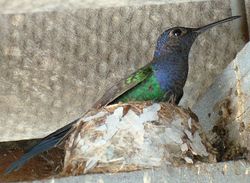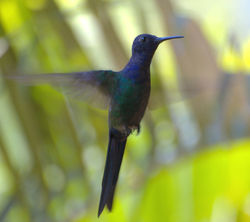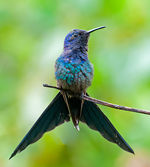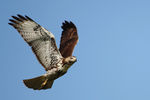Swallow-tailed hummingbird
| Swallow-tailed hummingbird |
|---|

|
| Scientific Classification |
|
| Scientific Name |
|
Eupetomena Macroura |
| Eupetomena Macroura flying |
The swallow-tailed hummingbird is a long and thin bird, being able to lengthen up to 6 and a half inches long. This bird is considered to be one of the larger hummingbirds, though they only way 9 grams (.31 oz). The hummingbird can be various colors, such as blue, green, purple, black, and grey. These colors usually are the color of their natural habitat, so they can hide from predators. They get their name from their swallow -like tail. [2] An easy way you can tell the difference between the male and female swallow-tailed hummingbirds is that the males' plumage (the feathers of a bird that make up their distinctive markings or coloration patterns) is green, [3] except for their head, upper chest, and tail. These parts, on the males, have blackish-brown color of flight feathers. The females, on the other hand, have duller plumage. They are also a quarter of the size of the males. [4]
Life Cycle
The swallow-tailed hummingbird starts breeding at age twelve. Then the eggs are taken care of by their mother, and then hatch after 15-16 days. When born, they are usually featherless. They then grow feathers five days after hatching, and their tail feathers grow three days after hatching. The young birds leave after 22-24 days with their mother, then are independent twenty-three weeks after leaving their nest. [5] The swallow-tailed hummingbirds are seen carrying nest materials, mostly during July through September. Their nests are usually built with lichen and moss, and are held together with spider webs. The nests can be mostly found in relatively small trees, less than 3 meters (10 feet) above the ground, although they can be up to 15 meters (49 feet). They lay only one or two eggs per nest, and are incubated by the mother. [6]
Ecology
The Swallow-tailed Hummingbird has many predators as a baby, such as: crows, jays, roadrunners, arboreal snakes, cats, and lastly mice. Once they get older they don't have as many predators, with the help of how fast they can fly. The adult predator is the Hawk. They mostly eat nectar from an flower, but occasionally they eat insects. [7] The Eupetomena Macroura live mostly in Brazil. They tend to stay away from rainforests in the Amazon Basin area, but if they do stay in the Amazon Basin, it's on the edges of the forest (mostly the eastern and southern). [8] The Swallow-tailed Hummingbird can live in a variety of places such as: forests, forest edges, savanna-like areas, plantations, parks, and gardens. [9] They tend to like treeless cities, which explains why they don't really like forests that much. [10] The Swallow-tailed Hummingbird, while in the Amazon Basin, like to stay near the Tapajós River. They are mostly resident (non-migratory) birds, but some do travel very short amounts (1,500 miles) North or South during dry winter months. As the years have gone on, they have started to realize, that this hummingbird is increasing it's numbers in the more southern areas. [11] The Swallow-Tailed Hummingbird is only native to America. [12]
Video
A Swallow-tailed Hummingbird sighting
References
- ↑ . [1]. Web. Last accessed December 16, 2016, Unknown Author
- ↑ Swallow-TailedHumming Worlds. Web. last accessed December 14, 2016, unknown author
- ↑ BasicsAll About Birds. Web. last updated April 20, 2008, unknown author
- ↑ Johnson, Sibylle. Hummingbird-InfoBeauty of Birds. Web. last accessed December 14, 2016
- ↑ B.BuddiesBirding Buddies. Web. last accessed December 15, 2016, unknown author
- ↑ Lourenco, Pedro. HummingbirdBirds of the World. Web. Last edited November 18, 2010
- ↑ Cielen, Davy. DiscoverBlogSpot. Web. Last edited August 19, 2011
- ↑ . Swallow-tailedWikipedia. Web. last accessed January 4, 2017, Unknown Author
- ↑ Beletsky, Les.GoogleGoogle Books. Web. last accessed January 4, 2017
- ↑ Brandão, Flávio Cruvinel.Beija-florFlickr. Web. Last accessed January 4, 2017
- ↑ Johnson,SibylleHummingbird-InfoBeauty of Birds. Web. last accessed January 4,2017
- ↑ . AlamyAlamy. Web. last accessed January 4, 2017, Unknown Author



